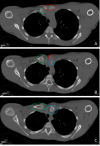Management of Posterior Sternoclavicular Joint Dislocation in a Teenager After a Direct Elbow Strike to His Clavicle: A Case Report
- PMID: 38174173
- PMCID: PMC10763836
- DOI: 10.7759/cureus.49916
Management of Posterior Sternoclavicular Joint Dislocation in a Teenager After a Direct Elbow Strike to His Clavicle: A Case Report
Abstract
Posterior dislocation of the sternoclavicular joint is a rare orthopedic injury and may result in complications with high mortality due to the location of the joint, accompanied by neurovascular, tracheal, and esophageal injuries. Therefore, an immediate diagnosis and treatment are necessary to prevent complications. In this case, a 13-year-old male patient received an elbow strike to the left clavicle while playing football. The patient presented to the emergency department with complaints of pain, a gap and deformity in the superior and medial part of his sternum, and numbness in his left upper extremity. For this orthopedic emergency, which is difficult to recognize on direct radiographs, a computed tomography was done, which detected a left sternoclavicular joint posterior dislocation. A closed reduction procedure was performed on the patient under sedation in the operating theatre. A serendipity view with the fluoroscopy showed a successful closed reduction. A shoulder arm sling was applied and the patient was followed regularly. In the fourth week, the shoulder arm sling was removed and exercises were started to increase joint movements. In the sixth week, muscle strengthening exercises were started and in the eighth week, a full range of motion was reached with full muscle strength without any deformity. In this case, possible mortal complications were prevented with early intervention in the posterior dislocation of the sternoclavicular joint. This case report shows that with timely rehabilitation, it is possible to achieve full joint range of motion of the shoulder and full muscle strength without deformity or the need for surgery.
Keywords: closed reduction; direct trauma to clavicle; dyspnea; posterior sternoclavicular joint dislocation; teenager sports injury.
Copyright © 2023, Gurcinar et al.
Conflict of interest statement
The authors have declared that no competing interests exist.
Figures



References
-
- Pediatric posterior sternoclavicular joint injuries. Chaudhry S. J Am Acad Orthop Surg. 2015;23:468–475. - PubMed
-
- Posterior sternoclavicular joint injuries in skeletally immature patients. Lee JT, Nasreddine AY, Black EM, Bae DS, Kocher MS. J Pediatr Orthop. 2014;34:369–375. - PubMed
-
- Posterior dislocation of the sternoclavicular joint and epiphyseal disruption of the medial clavicle with posterior displacement in sports participants. Laffosse JM, Espié A, Bonnevialle N, et al. J Bone Joint Surg Br. 2010;92:103–109. - PubMed
-
- Tracheal stenosis caused by retrosternal dislocation of the right clavicle. Nakayama E, Tanaka T, Noguchi T, Yasuda J, Terada Y. Ann Thorac Surg. 2007;83:685–687. - PubMed
-
- Conservative management of sternoclavicular injuries. Yeh GL, Williams GR. Orthop Clin North Am. 2000;31:189–203. - PubMed
Publication types
LinkOut - more resources
Full Text Sources
Miscellaneous
